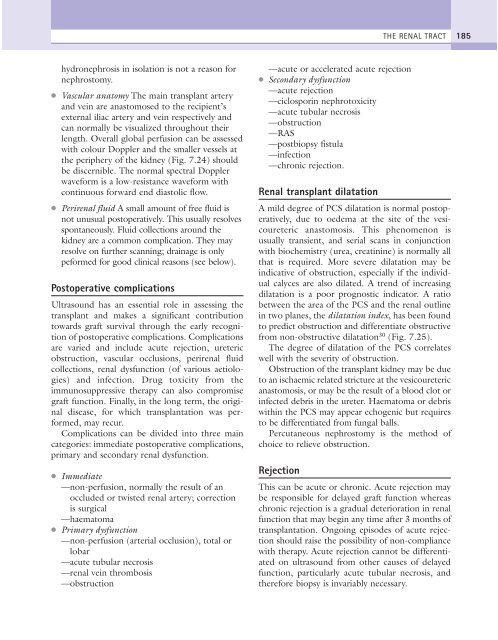9%20ECOGRAFIA%20ABDOMINAL%20COMO%20CUANDO%20DONDE
You also want an ePaper? Increase the reach of your titles
YUMPU automatically turns print PDFs into web optimized ePapers that Google loves.
THE RENAL TRACT 185<br />
●<br />
●<br />
hydronephrosis in isolation is not a reason for<br />
nephrostomy.<br />
Vascular anatomy The main transplant artery<br />
and vein are anastomosed to the recipient’s<br />
external iliac artery and vein respectively and<br />
can normally be visualized throughout their<br />
length. Overall global perfusion can be assessed<br />
with colour Doppler and the smaller vessels at<br />
the periphery of the kidney (Fig. 7.24) should<br />
be discernible. The normal spectral Doppler<br />
waveform is a low-resistance waveform with<br />
continuous forward end diastolic flow.<br />
Perirenal fluid A small amount of free fluid is<br />
not unusual postoperatively. This usually resolves<br />
spontaneously. Fluid collections around the<br />
kidney are a common complication. They may<br />
resolve on further scanning; drainage is only<br />
peformed for good clinical reasons (see below).<br />
Postoperative complications<br />
Ultrasound has an essential role in assessing the<br />
transplant and makes a significant contribution<br />
towards graft survival through the early recognition<br />
of postoperative complications. Complications<br />
are varied and include acute rejection, ureteric<br />
obstruction, vascular occlusions, perirenal fluid<br />
collections, renal dysfunction (of various aetiologies)<br />
and infection. Drug toxicity from the<br />
immunosuppressive therapy can also compromise<br />
graft function. Finally, in the long term, the original<br />
disease, for which transplantation was performed,<br />
may recur.<br />
Complications can be divided into three main<br />
categories: immediate postoperative complications,<br />
primary and secondary renal dysfunction.<br />
●<br />
●<br />
Immediate<br />
—non-perfusion, normally the result of an<br />
occluded or twisted renal artery; correction<br />
is surgical<br />
—haematoma<br />
Primary dysfunction<br />
—non-perfusion (arterial occlusion), total or<br />
lobar<br />
—acute tubular necrosis<br />
—renal vein thrombosis<br />
—obstruction<br />
●<br />
—acute or accelerated acute rejection<br />
Secondary dysfunction<br />
—acute rejection<br />
—ciclosporin nephrotoxicity<br />
—acute tubular necrosis<br />
—obstruction<br />
—RAS<br />
—postbiopsy fistula<br />
—infection<br />
—chronic rejection.<br />
Renal transplant dilatation<br />
A mild degree of PCS dilatation is normal postoperatively,<br />
due to oedema at the site of the vesicoureteric<br />
anastomosis. This phenomenon is<br />
usually transient, and serial scans in conjunction<br />
with biochemistry (urea, creatinine) is normally all<br />
that is required. More severe dilatation may be<br />
indicative of obstruction, especially if the individual<br />
calyces are also dilated. A trend of increasing<br />
dilatation is a poor prognostic indicator. A ratio<br />
between the area of the PCS and the renal outline<br />
in two planes, the dilatation index, has been found<br />
to predict obstruction and differentiate obstructive<br />
from non-obstructive dilatation 30 (Fig. 7.25).<br />
The degree of dilatation of the PCS correlates<br />
well with the severity of obstruction.<br />
Obstruction of the transplant kidney may be due<br />
to an ischaemic related stricture at the vesicoureteric<br />
anastomosis, or may be the result of a blood clot or<br />
infected debris in the ureter. Haematoma or debris<br />
within the PCS may appear echogenic but requires<br />
to be differentiated from fungal balls.<br />
Percutaneous nephrostomy is the method of<br />
choice to relieve obstruction.<br />
Rejection<br />
This can be acute or chronic. Acute rejection may<br />
be responsible for delayed graft function whereas<br />
chronic rejection is a gradual deterioration in renal<br />
function that may begin any time after 3 months of<br />
transplantation. Ongoing episodes of acute rejection<br />
should raise the possibility of non-compliance<br />
with therapy. Acute rejection cannot be differentiated<br />
on ultrasound from other causes of delayed<br />
function, particularly acute tubular necrosis, and<br />
therefore biopsy is invariably necessary.



